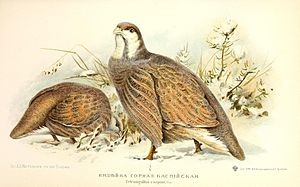Kaspi king chicken
| Kaspi king chicken | ||||||||||
|---|---|---|---|---|---|---|---|---|---|---|

Caspi King Chicken ( Tetraogallus caspius ) |
||||||||||
| Systematics | ||||||||||
|
||||||||||
| Scientific name | ||||||||||
| Tetraogallus caspius | ||||||||||
| ( Gmelin , 1784) |
The Caspi king chicken ( Tetraogallus caspius ), also called Caspian king chicken , is a species of bird from the genus of the king chickens ( Tetraogallus ) in the pheasant-like family (Phasianidae), which belong to the order of the galliformes . It is a mountain bird that can be found all year round in the alpine and subalpine belt and lives exclusively on the ground.
Appearance
The Kaspi king chicken reaches a body length of 56 to 63 centimeters. The wing span is 95 to 105 centimeters and the weight varies between 1.8 and 2.9 kilograms.
The adult male is slate gray on the upper side of the body, only the front back is creamy yellow. The throat is white, as is the front neck and the sides of the neck, which are separated from the front neck by a broad, gray-brown longitudinal band. The breast is blue-gray and has black, rounded spots in numerous individuals. The underbust and the belly are solid brown. The upper tail and the lower tail cover are white. The tail feathers are black-brown with a reddish tip.
The female is similar to the male, but usually has more black spots on the chest.
In its area of distribution, the Kaspi king chicken cannot be confused with any other species. It does not appear sympatric with other king chickens .
voice
Kaspi king chickens have a varied repertoire of voices. Most often heard are the calls of the males, which is a long, melodic whistle that starts with a low note and quickly increases at the end. It can be heard all year round, but especially frequently and loudly during courtship season. Females are somewhat more silent than males, but give off similar whistling sounds.
distribution and habitat
The distribution area of the Kaspi king's chicken are small, isolated partial areas of individual high mountain massifs from the Taur mountains and those of eastern Turkey to the Lesser Caucasus and the Sagros and Elburs mountains . The distribution area is declining. For example, the kaspi king hen was still found in the Talysh Mountains at the beginning of the 20th century .
The kaspi king chicken is a decidedly high mountain bird. It can be found all year round in the subalpine and alpine belts. In the Lesser Caucasus, for example, it inhabits the altitude range between 2400 and 4000 meters. It prefers rugged slopes with rocks and scree fields, meadows and smaller permanent snow fields. Due to the small amount of snow, the Kaspi king hen is able to stay at about the same altitude all year round. In winter, however, southern slopes are preferred.
Way of life
Kaspi king fowl are monogamous birds. The peak of the courtship falls in the second half of April, when the pairs separate from the winter groups and occupy their breeding grounds. The nest is a shallow hollow in the ground covered with dry leaves and blades of grass and some of the hen's belly feathers. The full clutch consists of five to twelve eggs. The breeding season is 28 to 29 days.
The food during the summer season consists mainly of the leaves, inflorescences and pods of legumes and bluebells . Insects don't seem to play a role. The composition of food in winter has not yet been investigated.
Duration
The IUCN classifies the Kaspi king chicken as not endangered, as the species occurs in a very large area. Exact inventory data is not available. The population is estimated at 2500 to 9000 breeding pairs for European territory. It is assumed that there are between 10,000 and 50,000 individuals worldwide.
supporting documents
literature
- RL Potapov, VE Fling (ed.): Handbook of the birds of the Soviet Union. Volume 4: Galliformes, Gruiformes. Aula Verlag, Wiesbaden 1989, ISBN 3-89104-417-8
Single receipts
- ↑ John B. Dunning Jr. (Ed.): CRC Handbook of Avian Body Masses . CRC Press (1992), ISBN 978-0-8493-4258-5 .
- ↑ Protopov & Fling, 1989, p. 75
- ^ Potapov & Fling, 1989, p. 76
- ^ Potapov & Fling, 1989, p. 76
- ^ Potapov & Fling, 1989, p. 76 and p. 77
- ^ Potapov & Fling, 1989, p. 77
- ^ IUCN website on the Kaspi King Chicken, accessed May 30, 2013
